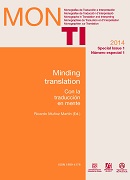Some thoughts about the conceptual / procedural distinction in translation: a key-logging and eye-tracking study of processing effort
Main Article Content
Abstract
Downloads
Article Details
The documents contained in these directories are included by the contributing authors as a means to ensure timely dissemination of scholarly and technical work on a non-commercial basis. It is understood that all persons copying this information will adhere to the terms and constraints invoked by each author's copyright. These works may not be reposted without the explicit permission of the copyright holder.
References
Alves, Fábio. (2007) “Cognitive effort and contextual effect in translation: a relevance-theoretic approach.” Journal of Translation Studies 10:1, pp. 18–35.
Alves, Fábio & Jose Luiz Gonçalves. (2003) “A Relevance Theory approach to the investigation of inferential processes in translation.” In: Alves, Fábio (ed.) 2003. Triangulating Translation: Perspectives in Process-Oriented Research. Amsterdam: John Benjamins, pp. 3–24.
Alves, Fábio & Jose Luiz Gonçalves. (2013) “Investigating the conceptual-procedural distinction in the translation process: A relevance-theoretic analysis of micro and macro translation units.” Target 25:1, pp. 107–124.
Alves, Fábio; Jose Luiz Gonçalves & Karina Szpak. (2012) “Identifying instances of processing effort in translation through heat maps: An eye-tracking study using multiple input sources.” In: Carl, Michael; Pushpak Bhattacharya & Kamal Kumar Choudhary (eds.) 2012. Proceedings of the First Workshop on Eye-tracking and Natural Language Processing. 24th International Conference on Computational Linguistics. Mumbai: COLING 2012, pp. 5–20.
Alves, Fábio; Adriana Pagano; Stella Neumann; Erich Steiner & Silvia HansenSchirra. (2010) “Translation units and grammatical shifts: towards an integration of product and process-based translation research.” In: Shreve, Gregory & Erik Angelone (eds.) 2010. Translation and Cognition. Amsterdam: John Benjamins, pp. 109–142.
Alves, Fábio; Adriana Pagano & Igor A. L. da Silva. (2009) “A new window on translators’ cognitive activity: Methodological issues in the combined use of eye-tracking, key-logging and retrospective protocols.” In: Mees, Inger; Fábio Alves & Susanne Göpferich (eds.) 2009. Methodology, Technology and Innovation in Translation Process Research. Copenhagen Studies in Language 37. Copenhagen: Samfundslitteratur, pp. 267–292.
Alves, Fábio & Daniel Vale. (2009) “Probing the unit of translation in time: Aspects of the design and development of a web application for storing, annotating, and querying translation process data.” Across Languages and Cultures 10:2, pp. 251–273.
Alves, Fábio & Daniel Vale. (2011) “On drafting and revision in translation: A corpus-linguistics oriented analysis of translation process data. TC3 Translation: Corpora, Computation, and Cognition 1:1, pp. 105–122.
Blakemore, Diane. (2002) Relevance and Linguistic Meaning: The Semantics and Pragmatics of Discourse Markers. Cambridge: Cambridge University Press. CARL, Michael & Martin Kay. (2011) “Gazing and typing activities during translation: A comparative study of translation units of professional and student translators.” Meta: Journal des Traducteurs 56:4, pp. 952–975.
Carl, Michael & Barbara Dragsted. (2012) “Inside the monitor model: Processes of default and challenged translation production.” TC3 Translation: Computation, Corpora, Cognition 2:1, pp. 127–145.
Flower, Linda & John R. Hayes. (1981) “A cognitive process theory of writing.” College Composition and Communication 32:4, pp. 365–387.
Hvelplund, Kristian T. (2011) Allocation of Cognitive Resources in Translation: An Eye-tracking and Key-logging Study. Unpublished PhD Thesis. Copenhagen Business School. Electronic version available at: http://openarchive.cbs.dk/bitstream/handle/10398/8314/Kristian_T_Hvelplund_SL.pdf?sequence=1
Jakobsen, Arnt L. & Kristian T. Hvelplund Jensen. (2008) “Eye movement behaviour across four different types of reading tasks.” In: Göpferich, Susanne; Arnt L. Jakobsen & Inger M. Mees (eds.) 2008. Looking at Eyes: Eye-Tracking Studies of Reading and Translation Processing. Copenhagen Studies in Language 36. Copenhagen: Samfundslitteratur, pp. 103-124.
Just, Marcel A. and Patricia A. Carpenter. (1980) “A theory of reading: From eye fixations to comprehension.” Psychological Review 87:4, pp. 329–354.
Pavlovi , Nataša & Kristian T. Hvelplund Jensen. (2009) “Eye tracking translation directionality.” In: Pym, Anthony & Alexander Perekrestenko (eds.) 2009. Translation Research Projects 2. Universitat Rovira i Virgili, Tarragona, pp. 101–119. Electronic version available at: http://www.tobii.com/Global/Analysis/Marketing/Research%20Paper/linguistics%20psychology/Eye%20tracking%20translation%20directionality.pdf
Rayner, Keith. (1998) “Eye movements in reading and information processing: 20 years of research.” Psychological Bulletin 124:3, pp. 372–422.
Rayner, Keith A. & Sara C. Sereno. (1994) “Eye movements in reading: Psycholinguistic studies.” In: Gernsbacher, Morton A. (ed.) 1994. Handbook of Psycholinguistics. San Diego: Academic Press, pp. 57–81.
Schilperoord, Joost. (1996) It’s about time. Temporal Aspects of Cognitive Processes in Text Production. Utrecht: Rodopi.
Sperber, Dan & Deirdre Wilson. (1986/1995) Relevance: Communication and Cognition. 2nd edition. Oxford: Blackwell.
Wilson, Deirdre. (2011) “The conceptual-procedural distinction: past, present, and future.” In: Escandell-Vidal, Victoria; Manuel Leonetti & Aoife Ahern (eds.) 2011. Procedural Meaning: Problems and Perspectives. London: Emerald, pp. 3–28.


